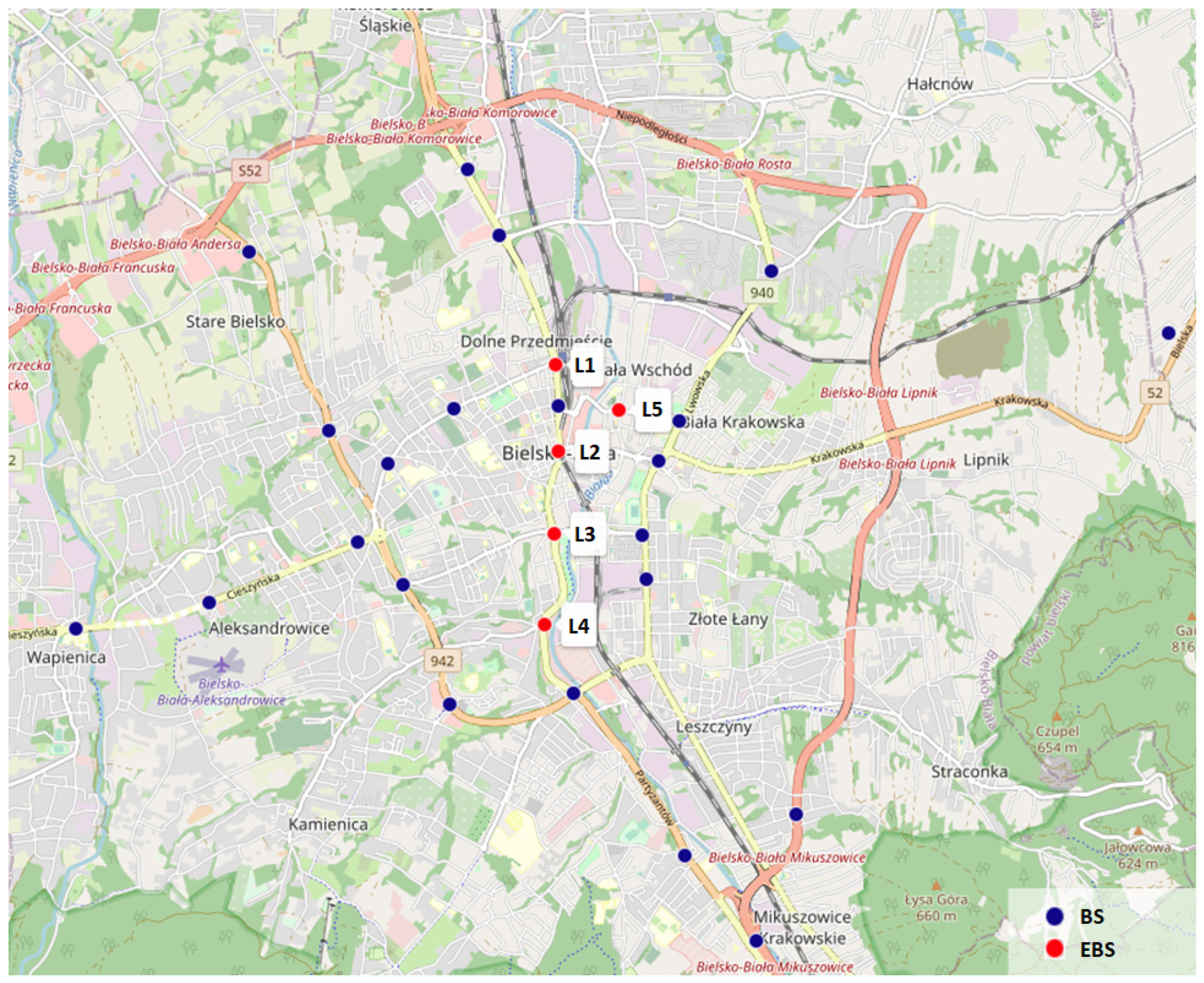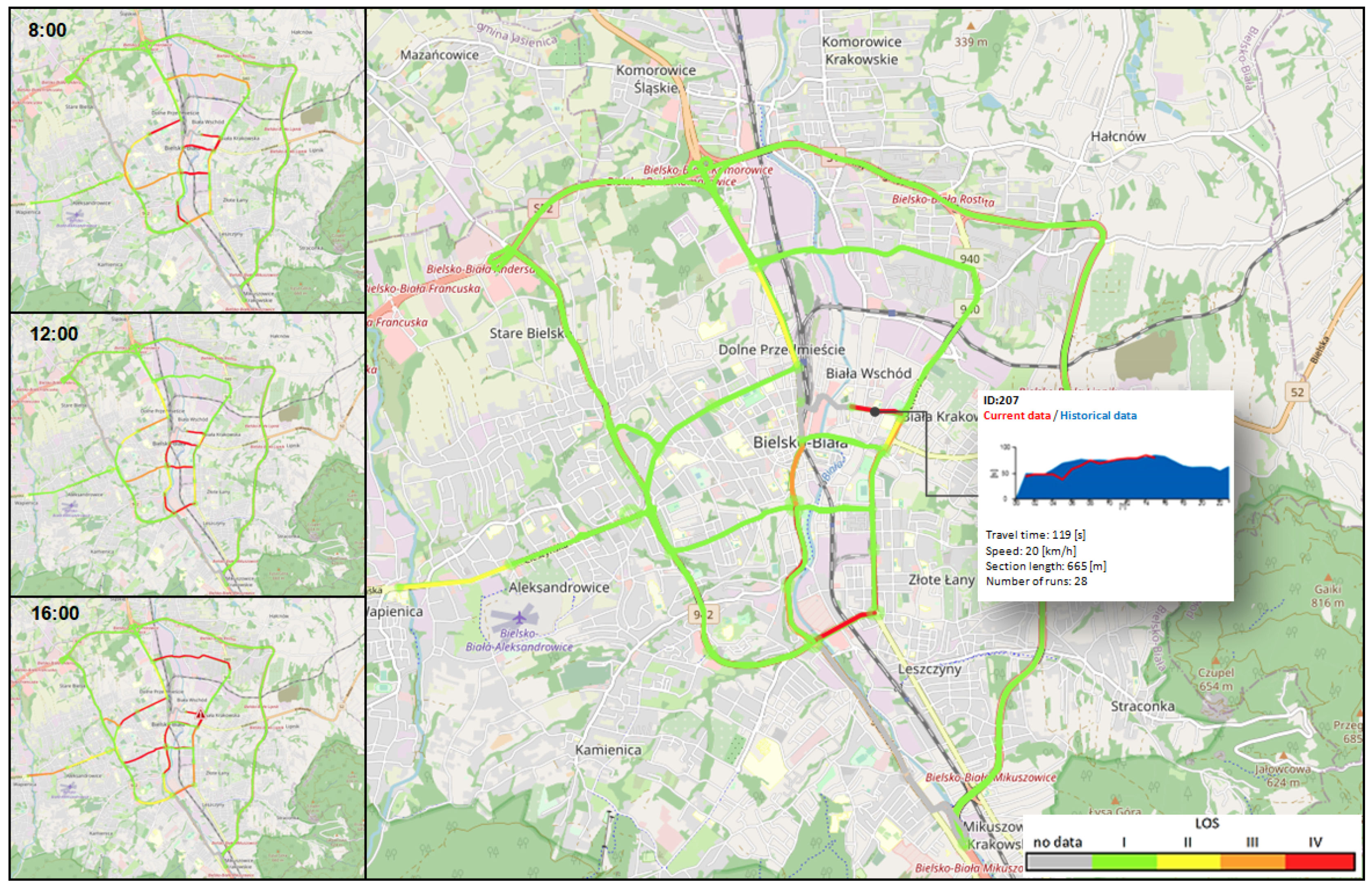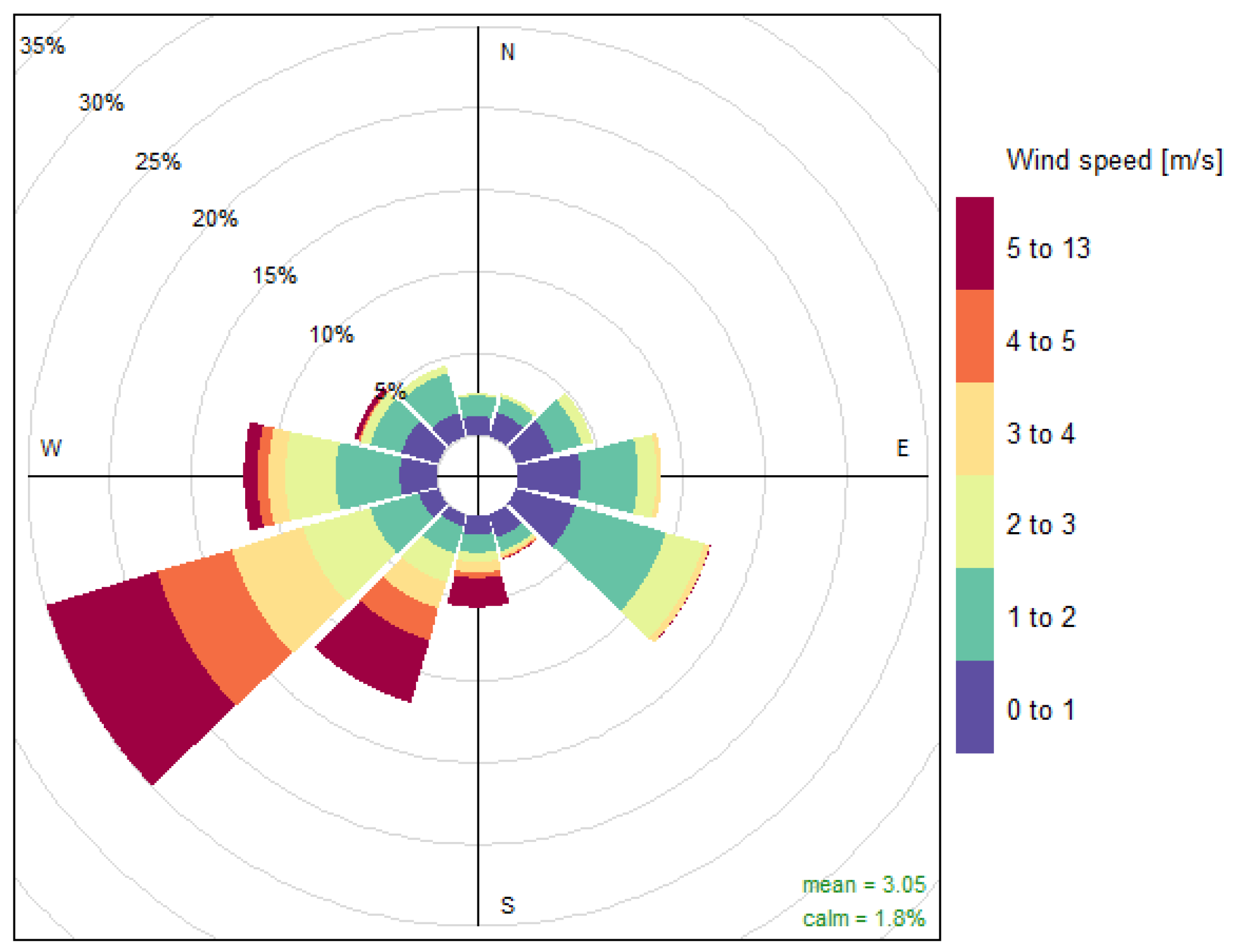An Integrated System for Simultaneous Monitoring of Traffic and Pollution Concentration—Lessons Learned for Bielsko-Biała, Poland
Abstract
:1. Introduction
2. Materials and Methods
2.1. Site Description
2.2. Measurement System
2.3. Data Processing
3. Results and Discussion
3.1. Meteorological Conditions and Urban Background Pollution
3.2. Characterization of Traffic and the Vicinity of Intersections in Locations Analyzed
3.3. Air Quality in the Vicinity of Roads
3.4. Prediction of the PM2.5 Concentration in the Area of Intersections
- How good are correlated values of calculated concentrations from model and real concentrations?;
- How large a mean error for the calculated concentration of PM2.5 can be expected?;
- Does the model have a tendency to overestimate or underestimate the calculated concentration of PM2.5?;
- In how many cases is the model’s prediction of AQIPM2.5 false?
- The fact that R2 > 0.85 indicates that the adopted set of input parameters allows mapping of local conditions and prediction of PM2.5 concentration in the areas of intersections not covered by direct measurements;
- MAE is below 10 µg/m3 and thus the mean absolute error for the model is lower than the level of uncertainty of measurement;
- MAPE for the entire data set is 24%, with higher percentage errors to be expected in the case of low concentration levels (AQIPM2.5 6)—indeed for this subset of data the average percentage error is 47%;
- The FB value, which for an ideal model is equal to zero, indicates a slight tendency of the model to overestimate concentrations;
- The NMSE value, which is a measure that emphasizes the scatter in the entire data set has a small value;
- The Hit rate indicates in how many cases the conformity of the predicted and recorded air quality index was obtained. These metrics show that the model correctly indicated AQIPM2.5 in 72% of cases. The slight tendency to overestimate PM2.5 concentrations (FB < 0) translates into an indication of a lower than true air quality index in 19% of cases. This means that the model indicates more favorable conditions than are recorded in only 9% of cases.
4. Conclusions
- During the three months analyzed, for 5–10% of the total time the recorded PM concentrations at individual locations in Bielsko-Biała indicated unacceptable air quality;
- Traffic emission of PM2.5 more frequently lead to hotspot formation;
- Traffic-derived carbon monoxide emissions only slightly deteriorated the air quality in the vicinity of roads;
- Despite the close mutual proximity of the locations, the volume of traffic, traffic conditions and the immediate surroundings lead to significant variations in air quality;
- Transit time is a useful parameter characterizing traffic at intersections;
- A neural network-based model can be used to predict air quality due to PM2.5 concentrations at intersections, with acceptable accuracy;
- At locations with adverse ventilation conditions, a tendency to higher frequency of occurrence of moderate (AQIPM10 4) and sufficient air quality (AQIPM10 3) than in other locations even with more traffic was recognized. This confirms the important role of local conditions determining traffic-related pollution emission and dispersion, although, naturally, the general likelihood of local hotspots increases with increased urban background levels.
Author Contributions
Funding
Conflicts of Interest
References
- World Health Organization (WHO). Ambient (Outdoor) Air Pollution. Available online: http://www.who.int/news-room/fact-sheets/detail/ambient-(outdoor)-air-quality-and-health (accessed on 20 November 2021).
- The National Centre for Emissions Management (KOBIZE). Poland’s Informative Inventory Report. 2019. Available online: https://www.kobize.pl/uploads/materialy/materialy_do_pobrania/krajowa_inwentaryzacja_emisji/IIR_2019_Poland.pdf (accessed on 20 November 2021).
- European Environment Agency (EEA). Europe’s Urban Air Quality—Re-Assessing Implementation Challenges in Cities; EEA Report No 24/2018; Publications Office of the European Union: Luxembourg, 2019. [Google Scholar] [CrossRef]
- Munir, S.; Mayfield, M.; Coca, D.; Jubb, S.A. Structuring an integrated air quality monitoring network in large urban areas—Discussing the purpose, criteria and deployment strategy. Atmos. Environ. X 2019, 2, 100027. [Google Scholar] [CrossRef]
- Morawska, L.; Thai, P.K.; Liu, X.; Asumadu-Sakyi, A.; Ayoko, G.; Bartonova, A.; Bedini, A.; Chai, F.; Christensen, B.; Dunbabin, M.; et al. Applications of low-cost sensing technologies for air quality monitoring and exposure assessment: How far have they gone? Environ. Int. 2018, 116, 286–299. [Google Scholar] [CrossRef]
- Schneider, P.; Castell, N.; Vogt, M.; Dauge, F.R.; Lahoz, W.A.; Bartonova, A. Mapping urban air quality in near real-time using observations from low-cost sensors and model information. Environ. Int. 2017, 106, 234–247. [Google Scholar] [CrossRef]
- Weissert, L.F.; Alberti, K.; Miskell, G.; Pattinson, W.; Salmond, J.A.; Henshaw, G.; Williams, D.E. Low-cost sensors and microscale land use regression: Data fusion to resolve air quality variations with high spatial and temporal resolution. Atmos. Environ. 2019, 213, 285–295. [Google Scholar] [CrossRef]
- Weissert, L.; Alberti, K.; Miles, E.; Miskell, G.; Feenstra, B.; Henshaw, G.S.; Papapostolou, V.; Patel, H.; Polidori, A.; Salmond, J.A.; et al. Low-cost sensor networks and land-use regression: Interpolating nitrogen dioxide concentration at high temporal and spatial resolution in Southern California. Atmos. Environ. 2020, 223, 117287. [Google Scholar] [CrossRef] [Green Version]
- Miskell, G.; Alberti, K.; Feenstra, B.; Henshaw, G.S.; Papapostolou, V.; Patel, H.; Polidori, A.; Salmond, J.A.; Weissert, L.; Williams, D.E. Reliable data from low cost ozone sensors in a hierarchical network. Atmos. Environ. 2019, 214, 116870. [Google Scholar] [CrossRef] [Green Version]
- Lin, Y.-C.; Chi, W.-J.; Lin, Y.-Q. The improvement of spatial-temporal resolution of PM2.5 estimation based on micro-air quality sensors by using data fusion technique. Environ. Int. 2020, 134, 105305. [Google Scholar] [CrossRef]
- Cao, R.; Li, B.; Wang, Z.; Peng, Z.-R.; Tao, S.; Lou, S. Using a distributed air sensor network to investigate the spatiotemporal patterns of PM2.5 concentrations. Environ. Pollut. 2020, 264, 114549. [Google Scholar] [CrossRef]
- Badura, M.; Sówka, I.; Szymański, P.; Batog, P. Assessing the usefulness of dense sensor network for PM2.5 monitoring on an academic campus area. Sci. Total Environ. 2020, 722, 137867. [Google Scholar] [CrossRef] [PubMed]
- Mihăiţă, A.S.; Dupont, L.; Chery, O.; Camargo, M.; Cai, C. Evaluating air quality by combining stationary, smart mobile pollution monitoring and data-driven modelling. J. Clean. Prod. 2019, 221, 398–418. [Google Scholar] [CrossRef]
- Lim, C.C.; Kim, H.; Vilcassim MJ, R.; Thurston, G.D.; Gordon, T.; Chen, L.-C.; Lee, K.; Heimbinder, M.; Kim, S.-Y. Mapping urban air quality using mobile sampling with low-cost sensors and machine learning in Seoul, South Korea. Environ. Int. 2019, 131, 105022. [Google Scholar] [CrossRef] [PubMed]
- de Souza, P.; Anjomshoaa, A.; Duarte, F.; Kahn, R.; Kumar, P.; Ratti, C. Air quality monitoring using mobile low-cost sensors mounted on trash-trucks: Methods development and lessons learned. Sustain. Cities Soc. 2020, 60, 102239. [Google Scholar] [CrossRef]
- Kaivonen, S.; Ngai, E.C.-H. Real-time air pollution monitoring with sensors on city bus. Digit. Commun. Netw. 2020, 6, 23–30. [Google Scholar] [CrossRef]
- Lee, C.C.; Tran, M.; Choo, C.W.; Tan, C.P.; Chiew, Y.S. Evaluation of air quality in Sunway City, Selangor, Malaysia from a mobile monitoring campaign using air pollution micro-sensors. Environ. Pollut. 2020, 265, 115058. [Google Scholar] [CrossRef]
- Gressent, A.; Malherbe, L.; Colette, A.; Rollin, H.; Scimia, R. Data fusion for air quality mapping using low-cost sensor observations: Feasibility and added-value. Environ. Int. 2020, 143, 105965. [Google Scholar] [CrossRef]
- Adams, M.D.; Massey, F.; Chastko, K.; Cupini, C. Spatial modelling of particulate matter air pollution sensor measurements collected by community scientists while cycling, land use regression with spatial cross-validation, and applications of machine learning for data correction. Atmos. Environ. 2020, 230, 117479. [Google Scholar] [CrossRef]
- SM, S.N.; Reddy Yasa, P.; MV, N.; Khadirnaikar, S.; Rani, P. Mobile monitoring of air pollution using low cost sensors to visualize spatio-temporal variation of pollutants at urban hotspots. Sustain. Cities Soc. 2019, 44, 520–535. [Google Scholar] [CrossRef]
- Ma, X.; Longley, I.; Gao, J.; Salmond, J. Assessing schoolchildren’s exposure to air pollution during the daily commute—A systematic review. Sci. Total Environ. 2020, 737, 140389. [Google Scholar] [CrossRef] [PubMed]
- Abbass, R.A.; Kumar, P.; El-Gendy, A. Car users exposure to particulate matter and gaseous air pollutants in megacity Cairo. Sustain. Cities Soc. 2020, 56, 102090. [Google Scholar] [CrossRef]
- Feenstra, B.; Papapostolou, V.; Hasheminassab, S.; Zhang, H.; Boghossian, B.D.; Cocker, D.; Polidori, A. Performance evaluation of twelve low-cost PM2.5 sensors at an ambient air monitoring site. Atmos. Environ. 2019, 216, 116946. [Google Scholar] [CrossRef]
- Kosmopoulos, G.; Salamalikis, V.; Pandis, S.N.; Yannopoulos, P.; Bloutsos, A.A.; Kazantzidis, A. Low-cost sensors for measuring airborne particulate matter: Field evaluation and calibration at a South-Eastern European site. Sci. Total Environ. 2020, 748, 141396. [Google Scholar] [CrossRef] [PubMed]
- Liu, X.; Jayaratne, R.; Thai, P.; Kuhn, T.; Zing, I.; Christensen, B.; Lamont, R.; Dunbabin, M.; Zhu, S.; Gao, J.; et al. Low-cost sensors as an alternative for long-term air quality monitoring. Environ. Res. 2020, 185, 109438. [Google Scholar] [CrossRef]
- Mahajan, S.; Kumar, P. Evaluation of low-cost sensors for quantitative personal exposure monitoring. Sustain. Cities Soc. 2020, 57, 102076. [Google Scholar] [CrossRef]
- Qin, X.; Hou, L.; Gao, J.; Si, S. The evaluation and optimization of calibration methods for low-cost particulate matter sensors: Inter-comparison between fixed and mobile methods. Sci. Total Environ. 2020, 715, 136791. [Google Scholar] [CrossRef]
- Statistics Poland, Statistical Office in Katowice. Statistical Vademecum of Regional Servant. 2019. Available online: http://katowice/stat.gov.pl (accessed on 20 November 2021).
- Environmental Protection Inspectorate. Wskaźniki Średniego Narażenia na Pył PM2,5 dla Miast Powyżej 100 tyś. Mieszkańców i Aglomeracji Oraz Krajowy Wskaźnik Średniego Narażenia w 2017 Roku. Available online: https://powietrze.gios.gov.pl/pjp/content/exposure_dust_pm (accessed on 20 November 2021).
- European Environment Agency (EEA). European City Air Quality Viewer. Available online: https://www.eea.europa.eu/themes/air/urban-air-quality/european-city-air-quality-viewer (accessed on 20 November 2021).
- Brzozowski, K.; Ryguła, A.; Maczyński, A. The use of low-cost sensors for air quality analysis in road intersections. Transp. Res. Part D Transp. Environ. 2019, 77, 198–211. [Google Scholar] [CrossRef]
- Brzozowski, K.; Konior, A.; Maczyński, A.; Ryguła, A. An extension of real-time traffic monitoring system with air quality module. In Proceedings of the International Scientific Conference on Transport Means, Juodkrantė, Lithuania, 5–7 October 2016; Part I. pp. 75–79. [Google Scholar]
- Loga-Księska, W.; Sordyl, J.; Ryguła, A. Long-term urban traffic monitoring based on wireless multi-sensor network. Open Eng. 2020, 10, 197–208. [Google Scholar] [CrossRef]
- Pinto, J.A.; Kumar, P.; Alonso, M.F.; Andreão, W.L.; Pedruzzi, R.; Soares dos Santos, F.; Moreira, D.M.; Toledo de Almeida Albuquerque, T. Traffic data in air quality modeling: A review of key variables, improvements in results, open problems and challenges in current research. Atmos. Pollut. Res. 2020, 11, 454–468. [Google Scholar] [CrossRef]
- Brzozowski, K.; Maczyński, A.; Ryguła, A. Monitoring road traffic participants’ exposure to PM10 using a low-cost system. Sci. Total Environ. 2020, 728, 138718. [Google Scholar] [CrossRef] [PubMed]
- Environmental Protection Inspectorate. Polish Air Quality Index. Available online: https://powietrze.gios.gov.pl/pjp/current (accessed on 20 November 2021).
- Yang, J.; Shi, B.; Shi, Y.; Marvin, S.; Zheng, Y.; Xia, G. Air pollution dispersal in high density urban areas: Research on the triadic relation of wind, air pollution, and urban form. Sustain. Cities Soc. 2020, 54, 101941. [Google Scholar] [CrossRef]
- Carslaw, D.C.; Ropkins, K. Openair—An R package for air quality data analysis. Environ. Model. Softw. 2012, 27–28, 52–61. [Google Scholar] [CrossRef]
- Chapman, L.; Thornes, J.; Bradley, A. Rapid determination of canyon geometry parameters for use in surface radiation budgets. Theor. Appl. Climatol. 2001, 69, 81–89. [Google Scholar] [CrossRef]
- Eeftens, M.; Beekhuizen, J.; Beelen, R.; Wang, M.; Vermeulen, R.; Brunekreef, B.; Huss, A.; Hoek, G. Quantifying urban street configuration for improvements in air pollution models. Atmos. Environ. 2013, 72, 1–9. [Google Scholar] [CrossRef]
- University of Gothenburg. Department of Earth Sciences. Technical Report: Sky View Factor Calculator. User Manual Version 1.1. Available online: https://cms.it.gu.se/infoglueDeliverWorking/digitalAssets/1377/1377754_skyviewfactorcalculator-user-manual.pdf (accessed on 20 November 2021).
- R Core Team. R: A Language and Environment for Statistical Computing; R Foundation for Statistical Computing: Vienna, Austria, 2020; Available online: https://www.R-project.org/ (accessed on 12 April 2021).
- Wickham, H. Ggplot2: Elegant Graphics for Data Analysis; Springer: New York, NY, USA, 2016. [Google Scholar]
- Pan, L.; Yao, E.; Yang, Y. Impact analysis of traffic-related air pollution based on real-time traffic and basic meteorological information. J. Environ. Manag. 2016, 183, 510–520. [Google Scholar] [CrossRef]
- Pérez-Martínez, P.J.; de Fátima Andrade, M.; de Miranda, R.M. Heavy truck restrictions and air quality implications in São Paulo, Brazil. J. Environ. Manag. 2017, 202, 55–68. [Google Scholar] [CrossRef] [PubMed]
- Adams, M.D.; Kanaroglou, P.S. Mapping real-time air pollution health risk for environmental management: Combining mobile and stationary air pollution monitoring with neural network models. J. Environ. Manag. 2016, 168, 133–141. [Google Scholar] [CrossRef] [PubMed]
- Kamińska, J.A. The use of random forests in modelling short-term air pollution effects based on traffic and meteorological conditions: A case study in Wrocław. J. Environ. Manag. 2018, 217, 164–174. [Google Scholar] [CrossRef]
- Kayacan, E.; Khanesar, M.A. Fuzzy Neural Networks for Real Time Control Applications: Concepts, Modeling and Algorithms for Fast Learning; Butterworth-Heinemann: Oxford, UK, 2016. [Google Scholar] [CrossRef]












| Component | Measuring | Uncertainties | Operation Range |
|---|---|---|---|
| OnDynamic | Detection of Bluetooth devices | N/A | 2.4–2.5 GHz −20–50 °C |
| PMS5003 sensor | Particulate matter concentration | ±10 µg/m3 for conc. ≤100 µg/m3 ±10% for conc. ≥100 µg/m3 | 0–500 µg/m3 −10–60 °C |
| CO-B4 sensor | Carbon monoxide concentration | ±4 ppb | 0–1000 ppm −30–50 °C |
| AQI Class | AQIx 6 | AQIx 5 | AQIx 4 | AQIx 3 | AQIx 2 | AQIx 1 |
|---|---|---|---|---|---|---|
| Pollutant | ||||||
| CO (mg/m3) | 3 | 7 | 11 | 15 | 21 | >21 |
| PM2.5 (µg/m3) | 13 | 35 | 55 | 75 | 110 | >110 |
| PM10 (µg/m3) | 20 | 50 | 80 | 110 | 150 | >150 |
| Rate of Occurence (%) | ||||||
|---|---|---|---|---|---|---|
| AQI Class Location | AQIOV 6 | AQIOV 5 | AQIOV 4 | AQIOV 3 | AQIOV 2 | AQIOV 1 |
| L1 | 28.4 | 39.9 | 15.5 | 6.2 | 4.4 | 5.6 |
| L2 | 21.5 | 51.3 | 13.4 | 4.7 | 4.7 | 4.4 |
| L3 | 38.8 | 42.4 | 7.5 | 3.2 | 4.1 | 4 |
| L4 | 41.1 | 44.5 | 5.8 | 3.5 | 2.9 | 2.2 |
| L5 | 28.8 | 44.8 | 13 | 6.2 | 4 | 3.2 |
| Rate of Occurrence (%) | ||||||
|---|---|---|---|---|---|---|
| AQI Class | AQIPM10(b) 6 | AQIPM10(b) 5 | AQIPM10(b) 4 | AQIPM10(b) 3 | AQIPM10(b) 2 | AQIPM10(b) 1 |
| Urban background | 55.6 | 39.7 | 3.2 | 1.2 | 0.3 | 0 |
| Location | L1 | L2 | L3 | L4 | L5 |
|---|---|---|---|---|---|
| SVF Value (−) | 0.92 | 0.86 | 0.96 | 0.94 | 0.58 |
| Location | L1 | L2 | L3 | L4 | L5 |
|---|---|---|---|---|---|
| Traffic volume (6 a.m.–6 p.m.) (veh./12-h) | 33,547 | 33,398 | 34,748 | 23,950 | 22,618 |
| Morning peak (veh./h) | 3011 | 3158 | 3526 | 2314 | 1943 |
| Afternoon peak (veh./h) | 3109 | 3276 | 3592 | 2347 | 2249 |
| Average flow (veh./h) | 2837 | 2839 | 2917 | 2016 | 1889 |
| Share of heavy vehicles | 6% | 3% | 4% | 3% | 5% |
| Rate of Occurrence(%) | ||||||
|---|---|---|---|---|---|---|
| AQI Class Location | AQIPM10 6 | AQIPM10 5 | AQIPM10 4 | AQIPM10 3 | AQIPM10 2 | AQIPM10 1 |
| L1 | 39.4 | 38.9 | 10.9 | 4.1 | 2.7 | 4 |
| L2 | 33.4 | 47 | 8.9 | 3.8 | 3 | 3.9 |
| L3 | 44.9 | 40.6 | 6 | 3.4 | 2.4 | 2.7 |
| L4 | 46.6 | 42.2 | 4.9 | 3.3 | 1.4 | 1.6 |
| L5 | 36.5 | 45.1 | 10 | 4.2 | 2 | 2.2 |
| AQI Class Location | AQIPM2.5 6 | AQIPM2.5 5 | AQIPM2.5 4 | AQIPM2.5 3 | AQIPM2.5 2 | AQIPM2.5 1 |
| L1 | 31.7 | 36.9 | 15.4 | 6 | 4.4 | 5.6 |
| L2 | 24.9 | 48 | 13.4 | 4.6 | 4.7 | 4.4 |
| L3 | 49.7 | 31.7 | 7.3 | 3.2 | 4.1 | 4 |
| L4 | 55.3 | 31 | 5.4 | 3.2 | 2.9 | 2.2 |
| L5 | 33 | 41 | 12.8 | 6.1 | 4 | 3.1 |
| Metric | Definition | Calculated Value |
|---|---|---|
| Coefficient of determination | 0.86 | |
| Mean Absolute Error | 6.85 µg/m3 | |
| Mean Absolute Percentage Error | 24% | |
| Fractional Bias | −0.02 | |
| Normalized Mean Square Error | 0.14 | |
| Hit rate | 0.72 |
Publisher’s Note: MDPI stays neutral with regard to jurisdictional claims in published maps and institutional affiliations. |
© 2021 by the authors. Licensee MDPI, Basel, Switzerland. This article is an open access article distributed under the terms and conditions of the Creative Commons Attribution (CC BY) license (https://creativecommons.org/licenses/by/4.0/).
Share and Cite
Brzozowski, K.; Ryguła, A.; Maczyński, A. An Integrated System for Simultaneous Monitoring of Traffic and Pollution Concentration—Lessons Learned for Bielsko-Biała, Poland. Energies 2021, 14, 8028. https://doi.org/10.3390/en14238028
Brzozowski K, Ryguła A, Maczyński A. An Integrated System for Simultaneous Monitoring of Traffic and Pollution Concentration—Lessons Learned for Bielsko-Biała, Poland. Energies. 2021; 14(23):8028. https://doi.org/10.3390/en14238028
Chicago/Turabian StyleBrzozowski, Krzysztof, Artur Ryguła, and Andrzej Maczyński. 2021. "An Integrated System for Simultaneous Monitoring of Traffic and Pollution Concentration—Lessons Learned for Bielsko-Biała, Poland" Energies 14, no. 23: 8028. https://doi.org/10.3390/en14238028
APA StyleBrzozowski, K., Ryguła, A., & Maczyński, A. (2021). An Integrated System for Simultaneous Monitoring of Traffic and Pollution Concentration—Lessons Learned for Bielsko-Biała, Poland. Energies, 14(23), 8028. https://doi.org/10.3390/en14238028






